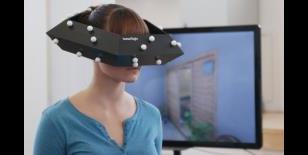
The Casual Conundrum
Playstation and Microsoft were undoubtedly, along with the rest of the world, blown away by the success of Nintendo’s little motion machine. Naturally, they each developed their own peripherals that would satisfy the now booming motion market. Playstation announced and released what it called the Playstation Move. Like the Wii, the Playstation Move coordinated with the Playstation Eye --a peripheral that had existed prior to the Move-- to allow natural motion controls. Also like the Wii, its most successful title was Sports Champions, a game that let the player partake in sports such as Disc-Golf and Archery. While the Playstation Move reviewed relatively well, it didn’t sell as much as it was meant to. Microsoft answered both Nintendo and Sony’s products with the Kinect. The Kinect is simply a camera that pairs with the Xbox 360 and observes the player. Unlike the Wii and Playstation 3, no extra controllers were required to use the Kinect. It would track the players movements entirely, whether jumping, kicking, or working-out. It also responded to the players voice. This allowed players to interact with their Xbox’s without ever having to touch a controller. At launch, the Kinect sold relatively well and was considered a success.
“Casual” gamers ate these devices up, so to speak. Gaming became a family activity. Parents could jump around and have bonding time with their kids. Friends could come over and dance the night away in sweaty bliss. Motion controls were truly a “game-changer” for some time. The “core” and “hardcore” audience, on the other hand, didn’t take to it quite as well. First and third person shooters are huge money makers for the gaming industry, but motion controls lacked the fidelity needed to play at a competitive level. The controls were such a drastic change from the classic controller that the gamer didn’t want to take the time to learn them and become proficient with them. So, the main money makers for the gaming industry --the core and hardcore audiences-- were beginning to resent the developers and publishers for focusing so heavily on motion controls. By late 2012, motion controls were still very much alive, but it seemed that they’d had their day in the spotlight. Developers and publishers alike were starting to understand that a change in focus was urgently needed.
The Return to Reliability
The next generation of consoles arrived, bringing with them a new set of controllers. The Wii U came first, implementing a dual-screen type of controller. The controller itself has all of the functionality of a classic controllers, but it also has a touchscreen that can double as the games monitor if a main output isn’t available. More interestingly, it can be used as a second screen for games and franchises that would benefit from such a thing. Games that require heavy inventory management or map checking especially benefit from the Wii U’s second screen function; allowing for these sometimes monotonous and cumbersome tasks to be handled without even pressing the pause button. The Wii U was also compatible with the original Wii’s Wiimote, catering to fans of that controller and giving multiple options to newcomers.
The Playstation 4 and Xbox One came much later than the Wii U, but were worth the wait. Both Sony and Microsoft had already produced stellar controllers for the previous generation of consoles, so while the expectations of them topping their previous efforts might not have been high, I feel that the majority of people were expecting them to at least match them. The Xbox One’s controller was unveiled alongside the console, featuring redesigned bumpers, triggers, and analog sticks for a more ergonomic feel. A sophisticated rumble feature was also built into the controller, though (not owning an Xbox One) I cannot speak for this feature’s implementation or quality. While all Xbox One’s shipped with the updated version of Kinect, the games being developed for it didn’t seem to be forcing Kinect implementation. For the most part, the Xbox One’s controller was more of what Xbox fans loved. The Playstation 4’s controller was unveiled during Sony’s February 2013 conference. Having stuck with the same controller design for more than 15 years, the Dualshock 4 was the biggest change to Playstation’s controller ever. Far more round than previous iterations, the control felt more natural in the hands of gamers. The triggers and analog sticks were given an overhaul as well. The triggers were now much more sturdy, and rather than sloping inward, they sloped outward for increased grip. The analog sticks were moved farther apart to prevent the notorious “thumb touching” that often happened with previous Dualshock controllers. They also were now concave rather than the usual convex shape; again, giving much more grip and comfort to the player. The most noticeable change to the Dualshock design, however, was the touchpad. Placed right where the Start and Select buttons would normally be, a large touchpad -- that doubled as a clickable button-- took their place. Replacing the Start and Select buttons were the Share and Options buttons.
These new controllers were a sign that the industry was going back to doing what made them successful in the past: catering to the core and hardcore audience rather than the casual. Even Nintendo went a more practical route with the Wii U’s gamepad that, save for the massive touchscreen in the center, was a basic controller made for the seasoned gamer. Microsoft stuck with the old adage “If it ain’t broke, don’t fix it,” and I don’t think anyone is complaining about that. Sony, while many believed their previous controllers to be superior, redesigned their controller to be more comfortable while implementing some new ideas.
Now that the history lesson is over, I can get into pure speculation and biased opinions --what we’ve all been waiting for!
The Virtues and Vices of Virtual Reality
Virtual Reality has been a concept that has interested me since I saw The Matrix. The idea of living in a world that’s so believable that my body and mind accept it for reality is a fascinating concept. I think this is why I love video games so much; they are the closest thing to a “virtual reality” that I will ever get to. They let me escape into worlds that are far more interesting than my own, but they only do this in a very limited way. Well, at least until recently. New devices like the Oculus Rift and Project Morpheus are beginning to float around the Internet that are deemed Virtual Reality devices, but do I see these things as a viable way of controlling and experiencing video games?
Yes and no. The Oculus Rift and Project Morpheus are essentially TV screens that are just super close to my face. With the assistance of gyroscopes and accelerometers, when I turn my head in any given direction, the character in-game follows suit. This gives the illusion that I am not just controlling the character with sticks and buttons, but that I am the character and my actions are his or hers. This is all great stuff. But the problem I find with this is that it’s still just a tiny step forward in the direction of actual virtual reality. I believe that this type of virtual reality can only work with certain types of games without feeling cumbersome. Since the only thing that I’m able to move with the Oculus Rift and Project Morpheus is my head, games like racing sims and flying sims make perfect sense for virtual reality. Stuck in a cockpit, the only thing I’d be moving in real life is my head, while I control everything else with my hands and feet without having to walk or move. This type of virtual experience wouldn’t be cheapened by holding a controller because that’s the gist of what’s actually happening in those situations.
I believe that first-person games like Skyrim or Team Fortress 2, on the other hand, would feel awkward and unnatural with virtual reality headsets. While I’m walking around exploring the land of Skyrim, or jumping through the air shooting fools in Team Fortress 2, the idea of turning my head here and there, while controlling my walking with an analog stick, seems uncomfortable and disorienting. Having never used a virtual reality headset like the Oculus Rift or Project Morpheus, I can’t say with certainty that I wouldn’t find these activities enjoyable. But I have a hunch that it would be something I’d use for about fifteen minutes, then never really touch again. To be completely trick my brain into thinking that the virtual reality I was inhabiting was, in fact, reality, the level of immersion would have to be greatly increased. I want to be able to walk and run through Skyrim as naturally as I would wander through a field or forest in real life. This might sound like I’m asking for a lot, but more intelligent people than myself have already begun working on such things ( https://www.youtube.com/wat... Low resistance surfaces allow this gamer to walk and run in Team Fortress 2, while a circular bar held him in place. This, combined with the Oculus Rift, provided a fully immersive gameplay experience, bordering on the type of virtual reality I’ve come to expect from science fiction films and novels.
So, will virtual reality replace the controller as we know it? For now, I doubt it. I see products like the Oculus Rift and Project Morpheus as supplementary devices for the gaming market. These devices have immense potential. At their current state, they seem like very niche products that only the hardcore virtual reality and gaming fans will want. If, however, virtual reality is combined with a system that allows for full-body movement --recreating it seamlessly in a virtual space-- then I think that these have a chance to change the way we game forever. Only time will tell how successful virtual reality becomes, and if it’ll ever replace the standard controller we’ve come to know and love. Until that time, I am content with using a controller, and letting my imagination take care of the rest.
PlayStation has been snatching up gacha-driven action RPGs left and right ever since Genshin Impact became a seismic hit on the console (alongside mobile and PC), and the next gacha game dropping on PS5 is none other than Neverness to Everness - tongue-twisting name, I know, but you can just think of it as the 'anime GTA' one.

Shift Up, the developer behind Stellar Blade, has released a new update, bringing the game to version 1.006.

Gran Turismo 7 has skipped one month of regular updates to deliver ‘Version 1.49’, which adds significant changes. Here are the most notable new features.
Hey everyone!
Sorry that this had to be split up into two separate blog posts, but the 15,000 character limit made it impossible for it to be a single entry.
Anyway, thank you for reading!